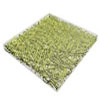| Mar 03, 2022 |
|
(Nanowerk News) The flip side of the convenience that electronic devices brings us, electronic waste presents a complex and growing challenge on the path toward a circular economy – a more sustainable economic system that focuses on recycling materials and minimizing waste.
|
|
E-Waste is now considered the fastest-growing waste stream in the world. According to the According to the Global E-waste Monitor 2020, the world generated 53.6 metric tonnes (Mt) of e-waste in 2019 – discarded products with a battery or plug such as computers and mobile phones – only 9.3 Mt (17%) of which was officially documented as formally collected and recycled.
|
|
Targeting a particular component of many electronic systems – sensors – researchers report a facile approach to fabricate biodegradable and recyclable piezoelectric sensors by embedding a molecular ferroelectric into a bacterial cellulose (BC) hydrogel.
|
|
As they report in ACS Nano (“A Biodegradable and Recyclable Piezoelectric Sensor Based on a Molecular Ferroelectric Embedded in a Bacterial Cellulose Hydrogel”), the hybrid sensors exhibit a high sensitivity that outperforms most of devices based on conventional functional biomaterials and are even comparable to those of detectors with typical ferroelectric polymers such as PVDF.
|
 |
| Schematics of the fabrication process to prepare the molecular ferroelectric/BC hybrid sensor. (Reprinted with permission by American Chemical Society)
|
|
For their BC hydrogel, the team used a natural polysaccharide polymer cellulose produced by microorganisms belonging to Gluconacetobacter xylinus. Besides its preferred biocompatibility, biodegradability, and renewability properties, BC possesses high crystallinity, water uptake capacity, and ionic exchangeability.
|
|
Furthermore, as the authors point out, BC possesses a 3D interconnected network structure composed of nanofibers with diameters of 10−100 nm, which endows its hydrogel with many other outstanding properties including high porosity, large specific surface area, low elastic modulus, and high flexibility.
|
|
For the purpose of realizing biodegradable and recyclable piezoelectric sensors, the researchers infused molecular ferroelectrics into BC membranes.
|
|
Molecular ferroelectrics are a kind of inorganic−organic hybrid material that consists of inorganic atomic frameworks and organic molecular groups, whose spontaneous polarization originates from the asymmetry of lattices and/or relative displacement of polar groups.
|
|
For this work, the team embedded imidazolium perchlorate (ImClO4), a molecular ferroelectric that possesses a piezoelectric coefficient (d33) of 46 pC N−1 that is superior to those of a typical ferroelectric polymer PVDF, into the BC hydrogel by evaporating a saturated ImClO4 solution.
|
|
The ImClO4/BC hybrid is biodegradable and recyclable. After the ImClO4/BC hybrid was immersed in pure water, the ImClO4 dissolved and formed a solution with imidazolium and perchlorate ions. It is suggested that the ImClO4 of the hybrid sensor can be fully redissolved by water.
|


